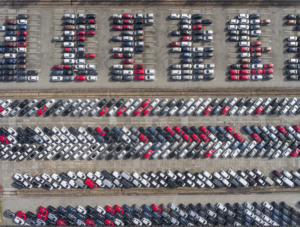Well, not exactly. There is not really a black-top-covered, state-sized plot of land devoted to parked cars. However, new studies have revealed the increasing amount of available parking in America with a predicted square mileage big enough to cover the Garden State.
Ask anyone who lives in or near an urban area and they’ll be the first to dispute the above statement. In a sense, parking naysayers may be right—places like Jackson, Wyoming have the amplest parking with more than 27 spots per household. On the other hand, cities like NYC have about half a parking stall per house—the least amount of parking availability in the United States, according to a study by the Research Institute for Housing America (RIHA).
While this is a huge disparity, it goes to show that in most places there is plenty of parking area. Apparently, parking is abundant enough that a New Jersey-shaped parking plot is feasible, according to “Parking and the City,” researchers Emma Kirkpatrick, Amélie Davis, and Bryan Pijanowski.
“Approximately 5 percent of the urban area in the Upper Great Lakes region was devoted to paved lots. … If this were scaled up to the entire conterminous U.S., the paved area (just for parking) would cover 7,092 square miles, nearly the entire state of New Jersey.”
So, if parking is indeed out there, why do long-stated beliefs of minimal vehicle parking still exist? This very question was studied in Seattle, Washington.
“The parking ‘problem’ in cities has been misunderstood for years, partly because comprehensive parking inventories weren’t available,” Eric Scharnhorst, the study’s author, writes. “Creating parking policies without knowing how much parking you have is like a doctor prescribing surgery without first diagnosing her patient.” Luckily, with the advent of new parking info and ever-advancing parking tech, the industry’s professionals now have the ability to give a proper diagnosis.
The brains behind parking software have prescribed pre-paid parking applications, “smart” kiosks, and “pay-by-plate” options in order to cure pains stemming from inefficient street side parking. Most recently, the city and suburbs of Philadelphia, PA have opted for a combination of these payment options. Benefits of increased options are twofold: payment is (most obviously) much less of a hassle, and additionally drivers are able to find spaces ahead of time using their computers or mobile devices. These choices put the increased amount of parking to use, saving motorists valuable time.
The same kind of parking guidance is also being applied to parking lots and garages everywhere. License plate recognition (LPR) cameras capture each and every vehicle plate in a parking area and relay this information to drivers via LED directional signs that change in real time.
There is no doubt that knowledge is truly power in the world of parking. As new information on the availability of space is recorded, the leaders of the industry are using it to develop an antidote for the thought-to-be suffering state of parking business. Drivers will now know before they go searching for a spot and the companies supplying these solutions will find themselves more efficient and profitable. So, (thankfully) the future of parking will not hold state-sized lots and will rather offer efficient use of the already growing amount of parking area.

